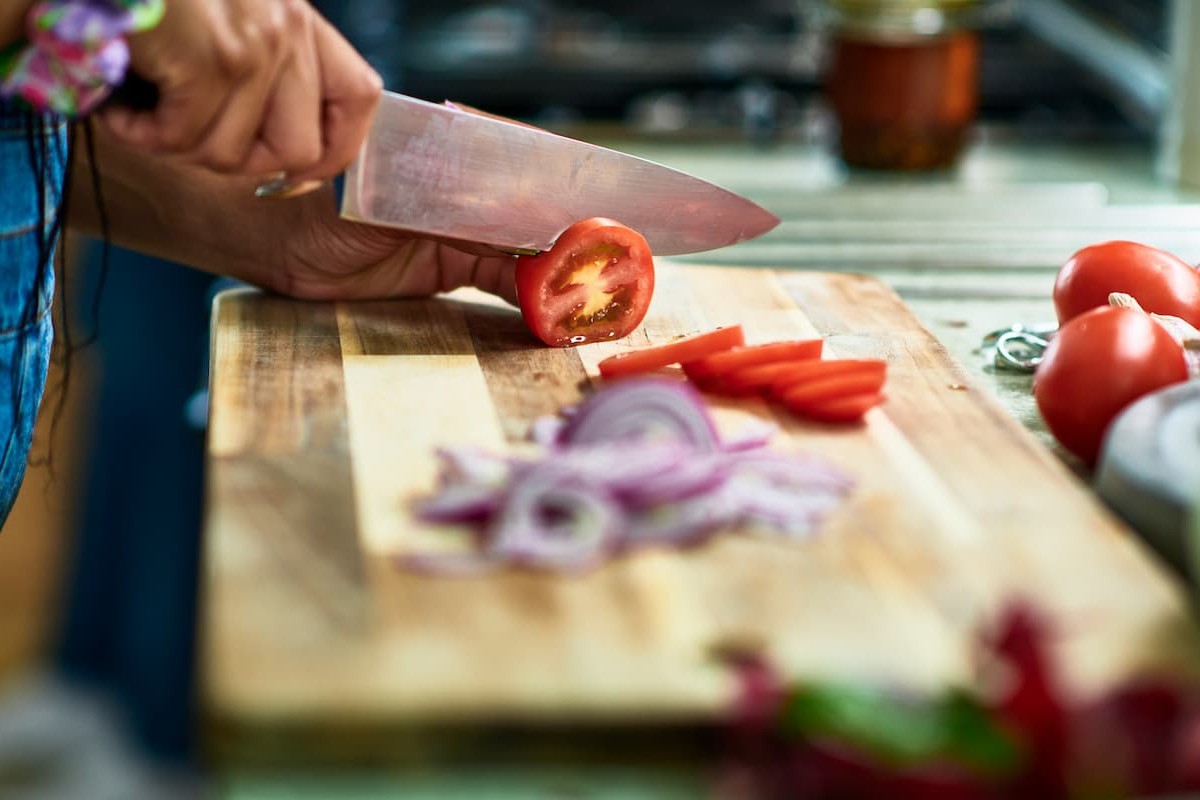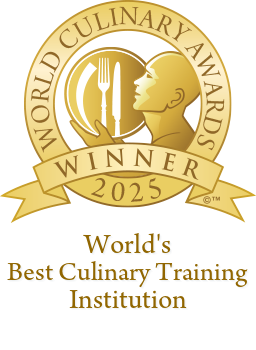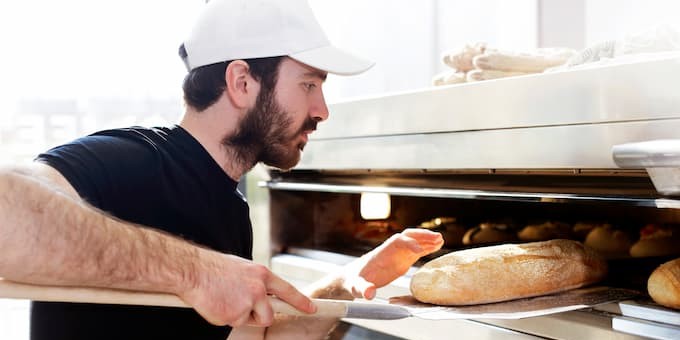Basic culinary skills for aspiring chefs

Whether you're an aspiring chef preparing to enroll in culinary school or someone eager to elevate their cooking prowess at home, mastering basic kitchen proficiencies lays the foundation for success.
These fundamental techniques form the backbone of cookery education and help individuals create delicious dishes with confidence and precision.
In this article, we'll explore essential skills that serve as a stepping stone towards kitchen excellence, preparing you for culinary school and beyond.
Mastering knife skills: the foundation of all cooking
Proficiency with knives is essential for any chef, serving as the foundation of efficient and safe food preparation.
Mastering proper techniques improves speed and precision in the kitchen while also ensuring consistent results in your culinary creations.
Let’s look at the main aspects of knife use you should learn.
Knife selection and maintenance
Begin by understanding different types of knives and their specific uses in the kitchen.
From chef's blades to paring and serrated knives, each serves a unique purpose in cutting, slicing and chopping ingredients.
Learn how to choose the right knife for the task at hand and maintain its sharpness through regular honing and occasional sharpening.
Grip and technique
Develop a comfortable and secure hold on the knife handle to maintain control and minimize fatigue during prolonged use.
Practice proper hand positioning, where your index finger and thumb grip the blade near the bolster (the junction of the blade and handle) while the remaining fingers curl around the handle for stability.
Master essential cutting techniques such as slicing, chopping, dicing and julienning to achieve uniformity in ingredient preparation.
Knife care and safety
Caution is vital when handling knives in the kitchen. Always use a stable cutting board to prevent slipping and ensure the knife remains sharp to minimize the risk of accidents. Practice safe techniques, such as keeping fingers curled under and away from the blade's path, and never leave knives submerged in water where they can be accidentally grabbed.
Speed and efficiency
As you refine your proficiency, focus on improving speed without sacrificing precision.
Work on developing a rhythmic chopping motion and mastering the ability to prepare ingredients quickly and accurately.
Efficient knife skills save time and contribute to a smoother workflow in the kitchen, helpful for professional chefs and home cooks alike.
Essential cooking techniques everyone should know
Once you know how to prepare ingredients, you need to know how to cook them. Mastering these essential techniques will boost your prowess and improve your culinary repertoire:
-
Sautéing: cooking ingredients quickly over medium to high heat in a small amount of fat, such as oil or butter. This technique is ideal for vegetables, meats and seafood, imparting a golden brown color and caramelized flavor to the food
-
Roasting and baking: heating food in an oven using dry heat. Roasting typically refers to cooking meat, poultry or vegetables at higher temperatures, while baking is used for bread, cakes and pastries at moderate heat. These both improve flavors and textures through caramelization and browning
-
Grilling: using direct heat from an open flame or hot coals to cook food quickly. It's perfect for meats, poultry, seafood and vegetables, imparting a smoky flavor and attractive grill marks
-
Boiling and simmering: boiling is heating in extremely hot water, while simmering maintains a gentle, steady heat. These techniques are used for cooking pasta, rice, grains and preparing soups, stews and sauces
-
Blanching and shocking: briefly cooking vegetables or fruits in boiling water, followed by immediate immersion in ice water to stop the process. This preserves color, texture and nutrients. It is commonly used for preparing salads, vegetable sides and garnishes
-
Braising: searing meat or vegetables in fat, then cooking slowly in a covered vessel with liquid (such as broth or wine) at low heat. This method tenderizes tough cuts and develops rich flavors, ideal for dishes such as pot roasts, stews and braises
-
Frying: using hot oil to cook food quickly, creating a crispy exterior while retaining moisture inside. Techniques include shallow frying (pan-frying) for pancakes and cutlets and deep frying for items such as french fries and tempura
-
Steaming: cooking food over boiling water vapor, retaining nutrients and natural flavors without added fats. It's used for vegetables, fish, dumplings and preserving the delicate textures of ingredients
-
Deglazing: a technique used to create flavorful sauces by adding liquid (such as wine, broth or vinegar) to a hot pan after cooking meat or vegetables. This loosens caramelized bits (fond) stuck to the bottom, incorporating them for added depth and richness
-
Seasoning and tasting: using salt, pepper, herbs, spices, acids (such as lemon juice or vinegar) and sweeteners to boost and harmonize flavors according to your taste preferences
If you want to look beyond these basic cooking skills, a culinary degree might be the right next step for you.
What you need to know about baking and pastry
Handling bread, doughs and pastries is a precise blend of food science and artistry, where ingredients transform through controlled chemical reactions.
Mastering bakery techniques is essential for achieving consistent and delectable results.
Let’s look at some of the fundamental principles and processes that define the craft of baking.
Ingredient ratios and formulas
Baking begins with understanding ingredient ratios and formulas.
Precise measurements of flour, sugar, fats, liquids, leavening agents (such as baking powder or yeast) and flavorings determine the structure, texture and flavor of baked goods.
Balancing these elements ensures proper hydration, gluten development and the chemical reactions necessary for a successful bake.
Leavening agents
Chemical raising agents such as baking powder and baking soda react with acids or moisture to produce carbon dioxide gas, causing the dough or batter to rise.
They play an essential role by creating volume and texture in baked goods. Yeast, a biological leavening agent, ferments sugars to create carbon dioxide and alcohol, resulting in airy breads and doughs with distinct flavors.
Gluten formation
A protein found in wheat flour, gluten develops when flour is combined with water and kneaded or mixed.
This gives baked goods structure and elasticity, contributing to their chewiness or tenderness.
Understanding gluten development is key to achieving the desired texture in breads, pastries and other treats.
Temperature control
To achieve uniformity and optimal results, the right temperature is vital.
Preheating the oven ensures even baking and proper rise, while monitoring internal temperatures with thermometers helps prevent over- or under-cooking.
Using room-temperature ingredients, especially butter and eggs, affect texture and consistency when mixed with other elements.
Mixing techniques
Different methods to combine ingredients impact the texture and structure of baked goods.
Creaming butter and sugar incorporates air for light and fluffy cakes while folding gently preserves air pockets in delicate batters.
The techniques vary based on the desired outcome, requiring skill and attention to detail.
Decorating and finishing
Beyond baking, decorating techniques add aesthetic appeal to baked goods.
Methods include icing, glazing, piping and garnishing with fruits, nuts or chocolate.
These touches help with presentation and improve the overall sensory experience of bakery treats.
Sauce-making: improving dishes with flavor
The secret weapons of culinary mastery, sauces are capable of changing ordinary meals into extraordinary experiences.
Whether it's a savory reduction, a creamy béchamel or a tangy salsa verde, mastering the art of sauces adds depth, complexity and richness to your cooking repertoire.
Below, we’ll take a closer look at the essential techniques and principles that infuse dishes with flavor through sauce making.
Flavor foundations
Sauce making involves building foundations using aromatic ingredients such as onions, garlic, herbs and spices.
These are sautéed or gently cooked to release their fragrant oils, infusing the dish with depth and complexity.
Understanding flavor profiles and ingredient combinations is key to creating harmonious sauces that complement the main components of a dish.
Thickening agents
Giving sauces body and viscosity, thickening agents include roux (a mixture of flour and fat), cornstarch and egg yolks.
Roux is commonly used in classic French recipes such as béchamel and velouté, while cornstarch and egg yolks are preferred for Asian-inspired condiments and custards respectively.
Mastery of these techniques ensures sauces have the ideal texture and consistency.
Reduction and concentration
Used to intensify flavors and thicken the consistency of sauces, reduction involves simmering them over low heat to evaporate excess liquid.
This process caramelizes sugars, improves taste and thickens naturally. It is commonly used in demi-glace, red wine sauces and balsamic glazes to achieve depth and complexity.
Emulsification
This is the process of combining two liquids that do not usually mix, such as oil and water, into a stable sauce.
This technique is essential for creating creamy and velvety condiments such as hollandaise, mayonnaise and vinaigrettes.
Achieving a proper emulsion requires patience, control and attention to detail to prevent separation and ensure a smooth texture.
How culinary school boosts your skills
An education in cooking provides aspiring chefs and students with a structured and immersive learning experience that significantly improves their skills and knowledge.
Culinary school can elevate your abilities in the kitchen and prepare you for a successful career in the industry with:
-
Foundational kitchen skills: cooking techniques, knife skills, food safety practices and kitchen management principles. You'll learn from experienced chefs who impart their expertise and guide you through hands-on training sessions. This knowledge forms the basis of your culinary path, equipping you with the abilities needed to execute recipes with precision and confidence
-
Exposure to diverse cuisines and ingredients: introduction to classic French techniques and Asian, Mediterranean and Latin American flavors enables you to broaden your repertoire and develop a nuanced understanding of diverse culinary traditions. This exposure encourages creativity and experimentation with ingredients and flavor combinations
-
Professional kitchen experience: you'll work in well-equipped facilities, simulating real-world scenarios and preparing you for the fast-paced nature of professional kitchens. Through practical training and internships, you'll refine your organizational skills, time management and teamwork abilities essential for thriving in culinary careers
-
Culinary industry information and networking: gain valuable insights into the food and beverage world, including trends, sustainability practices and business management strategies. Guest lectures, industry visits and networking events connect you with professionals and potential employers, expanding your career prospects and offering mentorship opportunities
Conclusion
Mastering basic cookery skills before entering culinary school lays a great foundation for success in the food industry.
These fundamental techniques can help aspiring chefs with their confidence and proficiency. They also pave the way for creative exploration and innovation.
By honing essential abilities such as knife handling, cooking methods and flavor development, individuals gain a deep understanding of ingredient manipulation and dish composition.
Familiarizing yourself with these foundational skills beforehand means you can maximize your learning in culinary school.
Beyond technical proficiency, these abilities build a passion for cooking, instill discipline in kitchen practices and cultivate an appreciation for the artistry of food preparation.
When you’re ready to start the next stage of your development as a chef, a French culinary institute will help you learn advanced methods and get hands-on experience.



